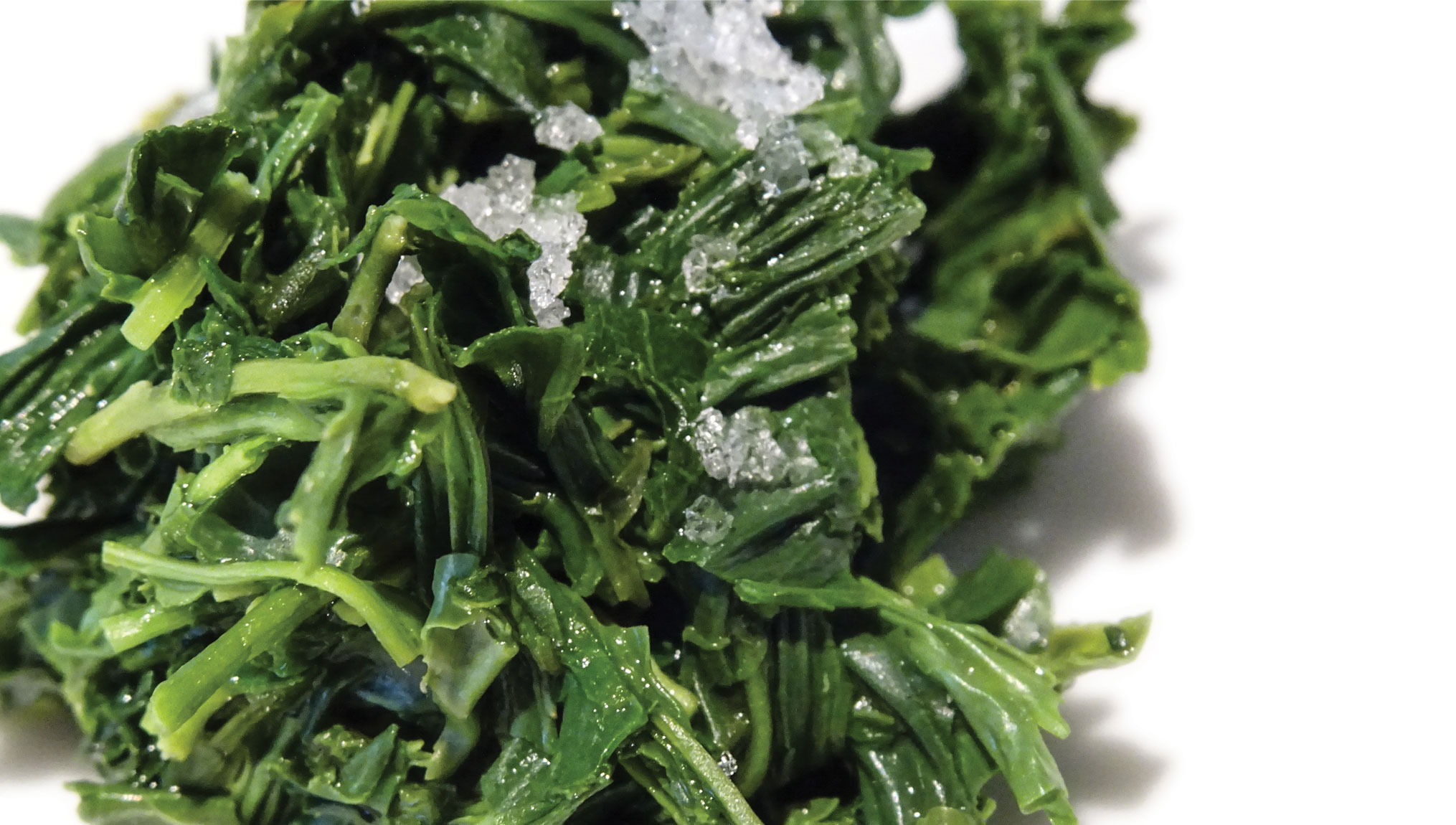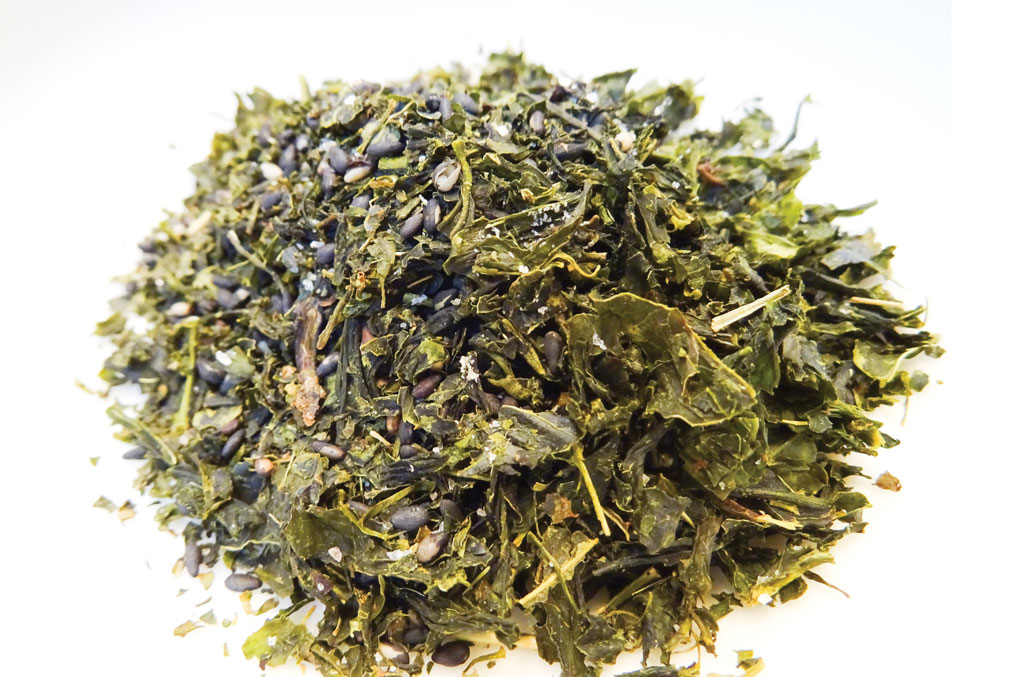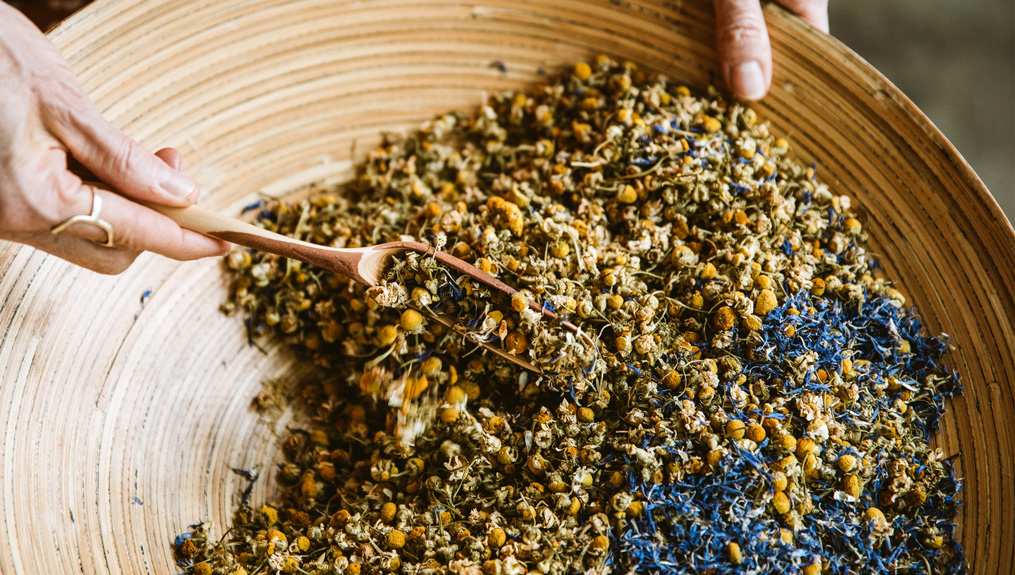Salty Snack: Gyokuro tea leaves prepared with rock salt. Photos by Greg Goodmacher
After savoring a pot of high-quality, organic Japanese green tea, don’t discard the wet leaves—eat them!
High-end tea cafés and tea specialists are transforming gyokuro tea leaves into a pleasant ritual of tea drinking and, as a pièce de résistance, savory dishes.
Eating Gyokuro Leaves
Yame City, Fukuoka Prefecture, is not only one of the best gyokuro tea-producing areas in Japan; it is home to the Tea Culture Museum, one of the country’s best places to drink gyokuro tea and eat gyokuro tea leaves. Staff in the museum’s on-site restaurant teach guests to brew Yame-grown gyokuro tea and eat the leaves. Their process brings forth a more extensive range of flavors than most tea drinkers imagine possible from one tea variety. The management of the museum permitted me to share their copyrighted recipe for “Shizuku-cha” (shizuku means “dripping”) with Fresh Cup readers.
Directions
- Spoon 3g (one heaping teaspoon) of Yame-grown gyokuro into a teacup.
- For the first cup of tea, gently pour in 20ml of hot water that has been left to cool to body temperature, starting from the outside and working your way to the center. Cover and let steep for 2 minutes. To drink the tea, shift the lid slightly to create a small gap, then take small sips. Relax and enjoy the rich flavor and aroma.
- For the second and third cups of tea, pour 20ml of 60° C/140° F hot water and wait 15–20 seconds before drinking.
- For the fourth cup of tea, fill the cup with 80° C/176° F hot water and wait about 15 seconds before drinking.
- The leftover leaves are chock-full of vitamins and minerals. You can dip them in vinegar sauce, dashi soy sauce, or rock salt, and eat them up.
I personally prefer eating gyokuro with just a little rock salt, which enhances the natural tastes of the leaves while adding some zest. Eating gyokuro in the fashion described above is still rare, but it is growing in popularity among tea connoisseurs. Tea museum staff report that high-end tea drinkers in China have a similar practice.
Furikake Made with Tea Leaves
Many Japanese restaurants serve white rice with various seasonings dusted on top, which are known as furikake, the Japanese word meaning “to sprinkle.” Generations ago, most families made their rice seasonings. Now, the mass-produced furikake found in the Asian foods sections of many grocery stores and served in many Japanese restaurants usually contain a mixture of the following: monosodium glutamate, salmon flakes, dried bits of tuna, sesame seeds, sugar, salt, dried egg particles, and powered miso.
However, a few tea companies are producing and selling high-quality green tea furikake. And, some families still make their rice toppings, which are almost always more delicious and healthier than the mass-produced versions.
My Japanese mother-in-law, who learned from her mother, taught my wife to transform wet tea leaves at the bottom of the teapot into furikake. This family recipe has passed with little variation across many generations.
Green tea is the main ingredient, but the type of tea varies. Most recently, we enjoyed sencha furikake; before that, it was hojicha furikake. Hojicha gives a strong roasted tea flavor while genmai tea (green tea mixed with rice kernels) adds the flavor of roasted rice. Gyokuro and sencha produce the most robust green tea flavors. Experiment to find what best matches your taste preferences. Except for powdered teas, any tea will work.
Start by making a large pot of green tea and slowly enjoy it. The amount of dry loose leaves you use depends on how much tea you want to drink, how strong you enjoy your tea, and how much furikake you want. The last time we made our furikake, we put one rounded tablespoon of sencha into our teapot.
Directions
- Make a pot of tea, using 1 Tbsp of high-quality green tea such as sencha or gyokuro. Drink and enjoy it.
- Heat a frying pan.
- Place the wet leaves on the frying pan. The heat should be between low and medium so the wet leaves dry but do not burn.
- Stir until the tea looks dry.
- Add a pinch of salt. Resume stirring.
- Add sesame seeds, about half the amount of the tea. Fry all the ingredients for about 30 seconds. You should smell the aroma of sesame seeds.
- Sprinkle over rice

Variations of Furikake
As mentioned above, experiment with different ingredients. Be creative. For example, one could add ginger flakes or shaved dry tuna or nori to the list of ingredients above. Start with small amounts because the flavors of some elements, such as dry tuna, can overwhelm the tea taste. Find a balance that pleases you. My family enjoys a simple furikake that allows us to enjoy the slight bitterness of tea with the natural sweetness of rice.
Throwing away the tasty leaves would be mottainai in the eyes of some Japanese tea lovers. “Mottainai” is a Japanese saying that expresses regret at the waste of a valuable resource. The mottainai ethos, prevalent decades ago, seemed to be lost, but with the growing environmental movement, younger generations are starting to adopt it into their daily lives. Why not repurpose your used tea leaves?













